*NURSING > EXAM > Exam 4: Chronic Kidney Disease NCLEX Questions | Answered with complete solutions (All)
Exam 4: Chronic Kidney Disease NCLEX Questions | Answered with complete solutions
Document Content and Description Below
Exam 4: Chronic Kidney Disease NCLEX Questions | Answered with complete solutions A patient is admitted to the hospital with CKD. The nurse understands that this condition is characterized by a. pr... ogressive irreversible destruction of the kidneys b. a rapid decrease in urine output with an elevated BUN c. an increasing creatinine clearance with a decrease in urine output d. prostration, somnolence, and confusion with coma and imminent death Patients with CKD experience an increase incidence of cardiovascular disease related to Select all that apply a. hypertension b. vascular calcifications c. a genetic predisposition d. hyperinsulinemia causing dyslipidemia e. increased high-density lipoprotein levels An ESRD patient receiving HD is considering asking a relative to donate a kidney for transplantation. In assisting the patient to make a decision about treatment, the nurse informs the patient that a. successful transplantation usually provides a better quality of life than that offered by dialysis b. if rejection of the transplanted kidney occurs, no further treatment for the renal failure is available c. HD replaces the normal function of the kidneys, and patients do not have to live with the continual fear of rejection d. the immunosuppressive therapy following transplantation makes the person ineligible to receive other forms of treatment if the kidney fails To assess the patency of a newly placed arteriovenous graft for dialysis, the nurse should Select all that apply a. monitor the BP in the affected arm b. irrigate the graft daily with low-dose heparin c. palpate the area of the graft to feel a normal thrill d. listen with a stethoscope over the graft to detect a bruit e. frequently monitor the pulses and neurovascular status distal to the graft A major advantage of peritoneal dialysis is a. the diet is less restricted and dialysis can be performed at home b. the dialysate is biocompatible and causes no long-term consequences c. high glucose concentrations of the dialysate causes a reduction in appetite, promoting weight loss d. no medications are required because of the enhances efficiency of the peritoneal membrane in removing toxins A kidney transplant recipient complains of having fever, chills, and dysuria over the past 2 weeks. What is the first action the nurse should take? a. assess temperature and initiate workup to rule out infection b. reassure the patient that this is common after transplantation c. provide warm cover for the patient and give 1 g acetaminophen orally d. notify the nephrologist that the patient has developed symptoms of acute rejection In replying to a patient's questions about the seriousness of her CKD, the nurse knows that the stage of CKD is based on what? a. total daily urine output b. GFR c. degree of altered mental status d. serum creatinine and urea levels The patient with CKD is receiving dialysis, and the nurse observes excoriations on the patient's skin. What pathophysiologic changes in CKD most likely occur that can contribute to this finding? Select all that apply a. dry skin b. sensory neuropathy c. vascular calcifications d. calcium-phosphate skin deposits e. uremic crystallization from high BUN What causes the GI manifestation of stomatitis in the patient with CKD? a. high serum sodium levels b. irritation of the GI tract from creatinine c. increased ammonia from bacterial breakdown of urea d. iron salts, calcium-containing phosphate binders, and limited fluid intake The patient with CKD is brought to the ED with Kussmaul respirations. What does the nurse know about CKD that could cause this patient's Kussmaul respirations? a. uremic pleuritis is occurring b. there is decreased pulmonary macrophage activity c. they are caused by respiratory compensation for metabolic acidosis d. pulmonary edema from HF and fluid overload is occurring Which serum laboratory value indicates to the nurse that the patient's CKD is getting worse? a. decreased BUN b. decreased sodium c. decreased creatinine d. decreased calculated GFR What is the most serious electrolyte disorder associated with kidney disease? a. hypocalcemia b. hyperkalemia c. hyponatremia d. hypermagnesemia What is the most appropriate snack for the nurse to offer a patient with stage 4 CKD? a. raisins b. ice cream c. dill pickles d. hard candy Which complication of CKD is treated with erythropoietin? a. anemia b. hypertension c. hyperkalemia d. mineral and bone disorder The patient with CKD is considering whether to use PD or HD. What are advantages of PD when compared to HD? Select all that apply a. less protein loss b. rapid fluid removal c. less cardiovascular stress d. decreased hyperlipidemia e. requires fewer dietary restrictions To prevent the most common serious complication of PD, what is most important for the nurse to do? a. infuse the dialysate slowly b. use strict aseptic technique in the dialysis procedures c. have the patient empty the bowel before the inflow phase d. reposition the patient frequently and promote deep breathing A man with ESRD is scheduled for HD following healing of an arteriovenous fistula. What should the nurse explain to him that will occur during dialysis? a. he will be able to visit, read, sleep, or watch TV while reclining in a chair b. he will be placed on a cardiac monitor to detect any adverse effects that may occur c. the dialyzer will remove and hold part of his blood for 20-30 minutes to remove the waste products d. a large catheter with two lumens will be inserted into the fistula to send blood to and return it from the dialyzer A patient rapidly progressing toward ESRD asks about the possibility of a kidney transplant. In responding to the patient, the nurse knows that what is a contraindication to kidney transplantation? a. hepatitis C infection b. coronary artery disease c. refractory hypertension d. extensive vascular disease During the immediate postoperative care of a recipient of a kidney transplant, what is a priority for the nurse to do? a. regulate fluid intake hourly based on urine output b. monitor urine-tinged drainage on abdominal dressing c. medicate the patient frequently for incisional flank pain d. remove the urinary catheter to evaluate the ureteral implant A patient received a kidney transplant last month. Because of the effects of immunosuppressive drugs and CKD, what complication of transplantation should the nurse be assessing the patient for? a. infection b. rejection c. malignancy d. cardiovascular disease The home care nurse visits a 34-yr-old woman receiving peritoneal dialysis. Which statement indicates a need for immediate follow-up by the nurse? a. "Drain time is faster if I rub my abdomen." b. "The fluid draining from the catheter is cloudy." c. "The drainage is bloody when I have my period." d. "I wash around the catheter with soap and water." The nurse preparing to administer a dose of calcium acetate to a patient with chronic kidney disease (CKD). Which laboratory result will the nurse monitor to determine if the desired effect was achieved? a. Sodium b. Potassium c. Magnesium d. Phosphorus Which statement regarding continuous ambulatory peritoneal dialysis (CAPD) would be most important when teaching a patient new to the treatment? a. "Maintain a daily written record of blood pressure and weight." b. "It is essential that you maintain aseptic technique to prevent peritonitis." c. "You will be allowed a more liberal protein diet once you complete CAPD." d. "Continue regular medical and nursing follow-up visits while performing CAPD." A patient with end-stage renal disease (ESRD) secondary to diabetes mellitus has arrived at the outpatient dialysis unit for hemodialysis. Which assessments should the nurse perform as a priority before, during, and after the treatment? a. Level of consciousness b. Blood pressure and fluid balance c. Temperature, heart rate, and blood pressure d. Assessment for signs and symptoms of infection A patient is recovering in the intensive care unit (ICU) 24 hours after receiving a kidney transplant. What is an expected assessment finding during the earliest stage of recovery? a. Hypokalemia b. Hyponatremia c. Large urine output d. Leukocytosis with cloudy urine output A patient with a 25-year history of type 1 diabetes mellitus is reporting fatigue, edema, and an irregular heartbeat. On assessment, the nurse notes newly developed hypertension and uncontrolled blood sugars. Which diagnostic study is most indicative of chronic kidney disease (CKD)? a. Serum creatinine b. Serum potassium c. Microalbuminuria d. Calculated glomerular filtration rate (GFR) A 78-yr-old patient has stage 3 CKD and is being taught about a low-potassium diet. The nurse knows the patient understands the diet when the patient selects which foods to eat? a. Apple, green beans, and a roast beef sandwich b. Granola made with dried fruits, nuts, and seeds c. Watermelon and ice cream with chocolate sauce d. Bran cereal with ½ banana and milk and orange juice During hemodialysis, the patient develops light-headedness and nausea. What should the nurse do first? a. Administer hypertonic saline. b. Administer a blood transfusion. c. Decrease the rate of fluid removal. d. Administer antiemetic medications. A 24-yr-old woman donated a kidney via a laparoscopic donor nephrectomy to a nonrelated recipient. The patient is experiencing significant pain and refuses to get up to walk. How should the nurse respond? a. Have the transplant psychologist convince her to walk. b. Encourage even a short walk to avoid complications of surgery. c. Tell the patient that no other patients have ever refused to walk. d. Tell the patient she is lucky she did not have an open nephrectomy. Which findings will the nurse expect when caring for a patient with chronic kidney disease (CKD)? Select all that apply a. Anemia b. Dehydration c. Hypertension d. Hypercalcemia e. Increased risk for fractures The nurse is caring for a patient with chronic kidney disease after hemodialysis. Which patient care action should the nurse delegate to the experienced unlicensed assistive personnel (UAP)? a. Assess the patient's access site for a thrill and bruit. b. Monitor for signs and symptoms of postdialysis bleeding. c. Check the patient's postdialysis blood pressure and weight. d. Instruct the patient to report signs of dialysis disequilibrium syndrome immediately. After the insertion of an arteriovenous graft (AVG) in the right forearm, a patient complains of pain and coldness of the right fingers. Which action should the nurse take? a. Elevate the patients arm above the level of the heart. b. Report the patients symptoms to the health care provider. c. Remind the patient about the need to take a daily low-dose aspirin tablet. d. Educate the patient about the normal vascular response after AVG insertion. Which statement by a patient with stage 5 chronic kidney disease (CKD) indicates that the nurses teaching about management of CKD has been effective? a. I need to try to get more protein from dairy products. b. I will try to increase my intake of fruits and vegetables. c. I will measure my urinary output each day to help calculate the amount I can drink. d. I need to take the erythropoietin to boost my immune system and help prevent infection. Which patient information will the nurse plan to obtain in order to determine the effectiveness of the prescribed calcium carbonate (Caltrate) for a patient with chronic kidney disease (CKD)? a. Blood pressure b. Phosphate level c. Neurologic status d. Creatinine clearance Before administering sodium polystyrene sulfonate (Kayexalate) to a patient with hyperkalemia, the nurse should assess the a. blood urea nitrogen (BUN) and creatinine. b. blood glucose level. c. patients bowel sounds. d. level of consciousness (LOC). The nurse has instructed a patient who is receiving hemodialysis about appropriate dietary choices. Which menu choice by the patient indicates that the teaching has been successful? a. Scrambled eggs, English muffin, and apple juice b. Oatmeal with cream, half a banana, and herbal tea c. Split-pea soup, whole-wheat toast, and nonfat milk d. Cheese sandwich, tomato soup, and cranberry juice A patient needing vascular access for hemodialysis asks the nurse what the differences are between an arteriovenous (AV) fistula and a graft. The nurse explains that one advantage of the fistula is that it a. is much less likely to clot. b. increases patient mobility. c. can accommodate larger needles. d. can be used sooner after surgery. When caring for a patient with a left arm arteriovenous fistula, which action will the nurse include in the plan of care to maintain the patency of the fistula? a. Check the fistula site for a bruit and thrill. b. Assess the rate and quality of the left radial pulse. c. Compare blood pressures in the left and right arms. d. Irrigate the fistula site with saline every 8 to 12 hours. When a patient who has had progressive chronic kidney disease (CKD) for several years is started on hemodialysis, which information about diet will the nurse include in patient teaching? a. Increased calories are needed because glucose is lost during hemodialysis. b. Unlimited fluids are allowed since retained fluid is removed during dialysis. c. More protein will be allowed because of the removal of urea and creatinine by dialysis. d. Dietary sodium and potassium are unrestricted because these levels are normalized by dialysis. Which action by a patient who is using peritoneal dialysis (PD) indicates that the nurse should provide more teaching about PD? a. The patient slows the inflow rate when experiencing pain. b. The patient leaves the catheter exit site without a dressing. c. The patient plans 30 to 60 minutes for a dialysate exchange. d. The patient cleans the catheter while taking a bath every day. When the nurse is taking a history for a patient who is a possible candidate for a kidney transplant, which information about the patient indicates that the patient is not an appropriate candidate for transplantation? a. The patient has metastatic lung cancer. b. The patient has poorly controlled type 1 diabetes. c. The patient has a history of chronic hepatitis C infection. d. The patient is infected with the human immunodeficiency virus. The nurse is caring for a patient who had kidney transplantation several years ago. Which assessment finding may indicate that the patient is experiencing adverse effects to the prescribed corticosteroid? a. Joint pain [Show More]
Last updated: 7 months ago
Preview 4 out of 16 pages

Loading document previews ...
Buy this document to get the full access instantly
Instant Download Access after purchase
Buy NowInstant download
We Accept:

Reviews( 0 )
$16.00
Can't find what you want? Try our AI powered Search
Document information
Connected school, study & course
About the document
Uploaded On
Dec 04, 2024
Number of pages
16
Written in
Additional information
This document has been written for:
Uploaded
Dec 04, 2024
Downloads
0
Views
15

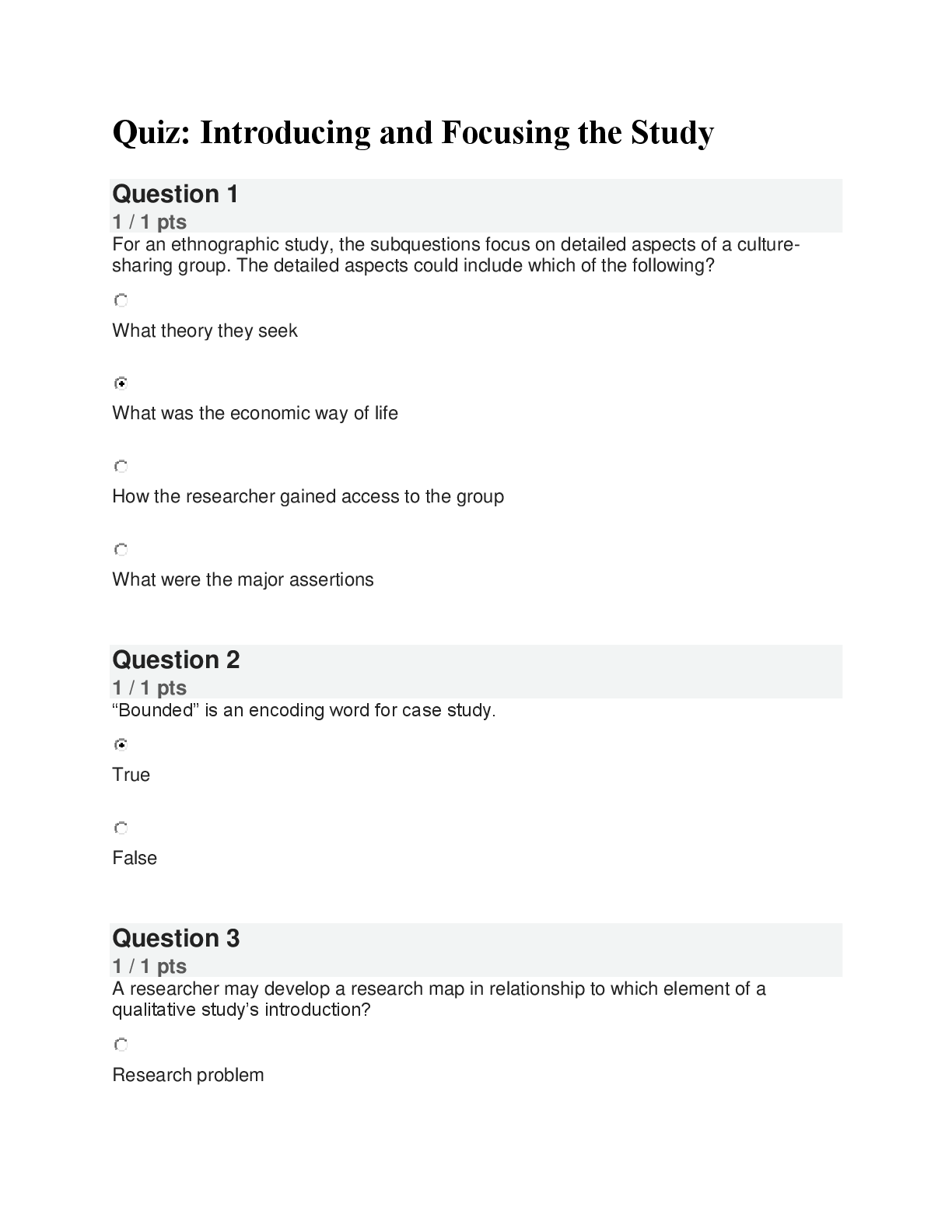
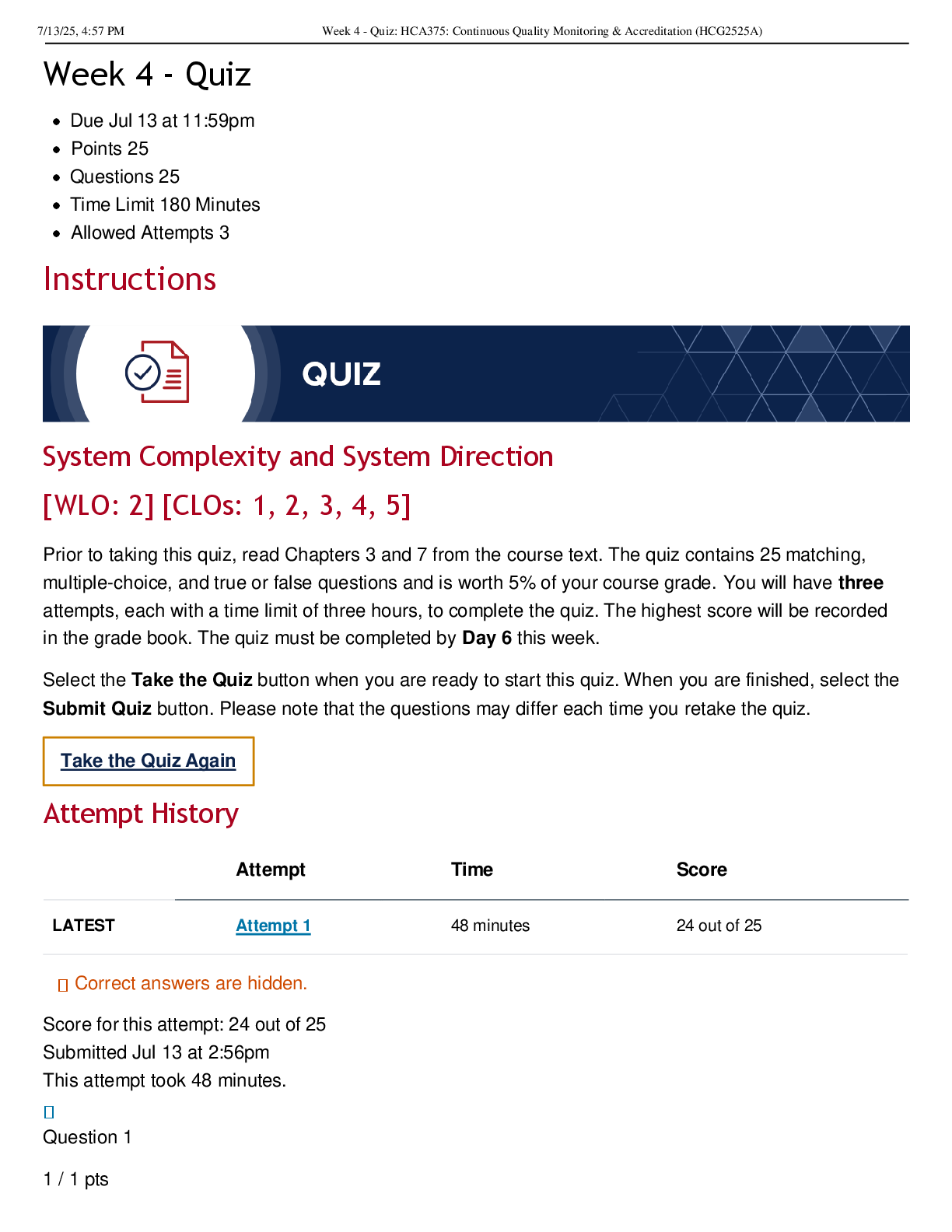
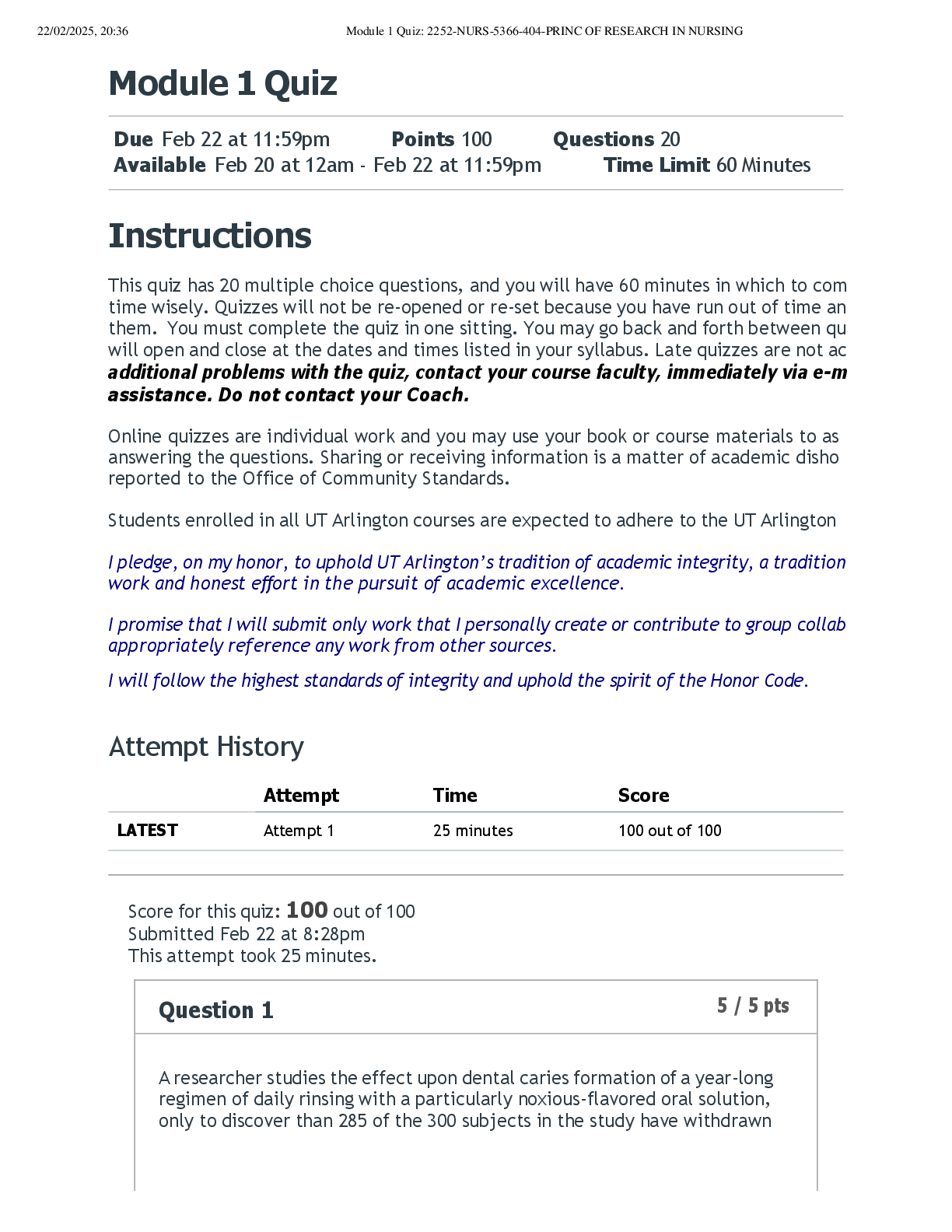
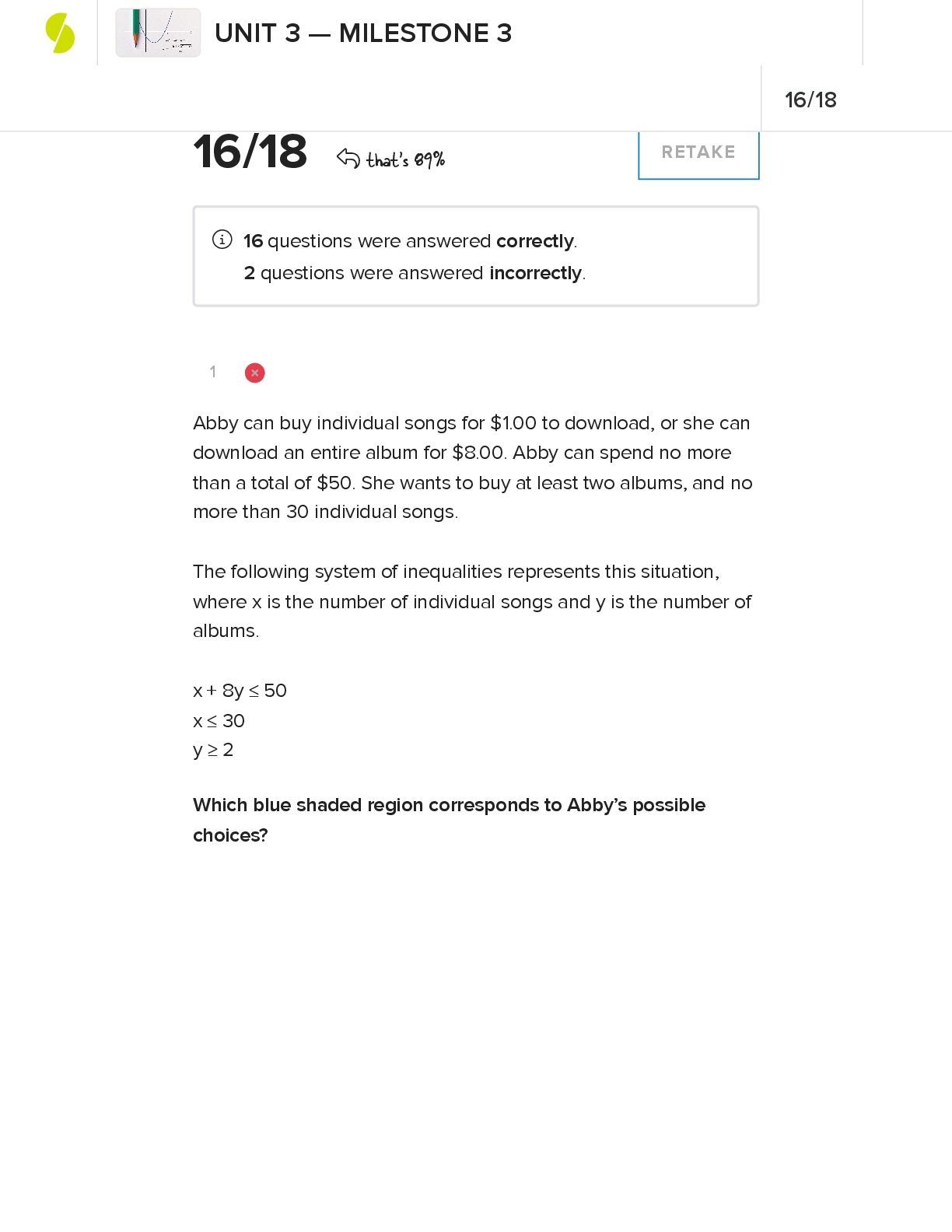
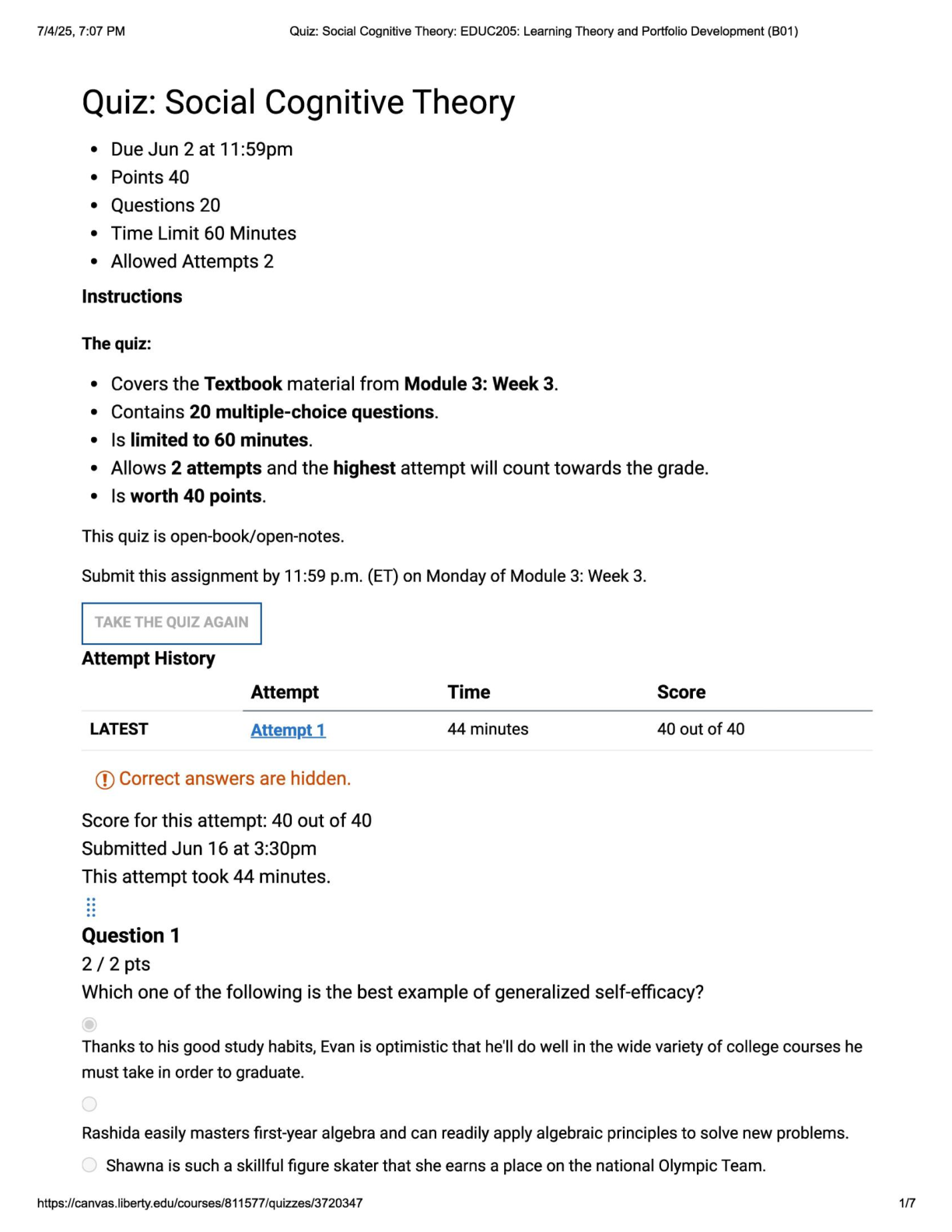
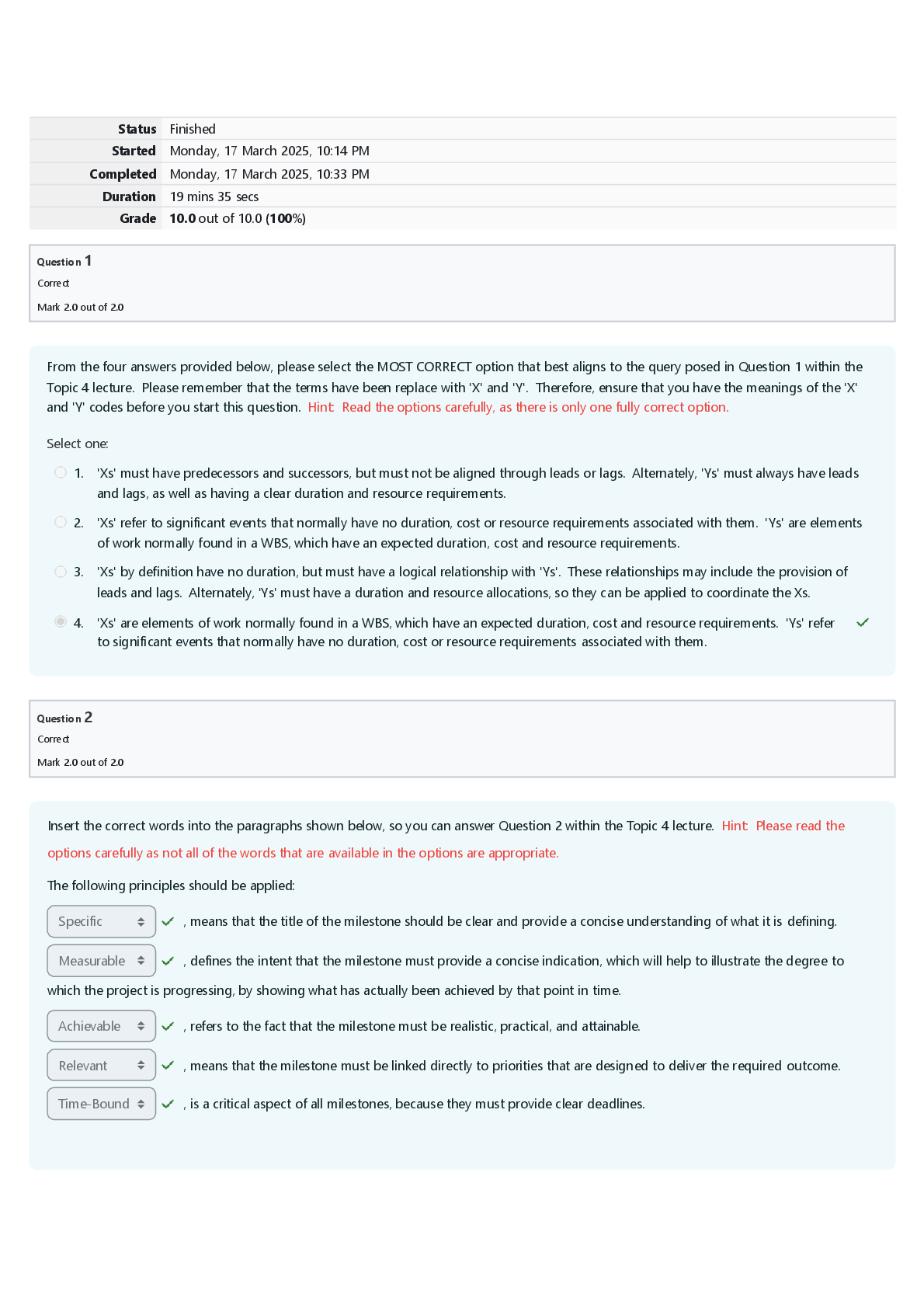
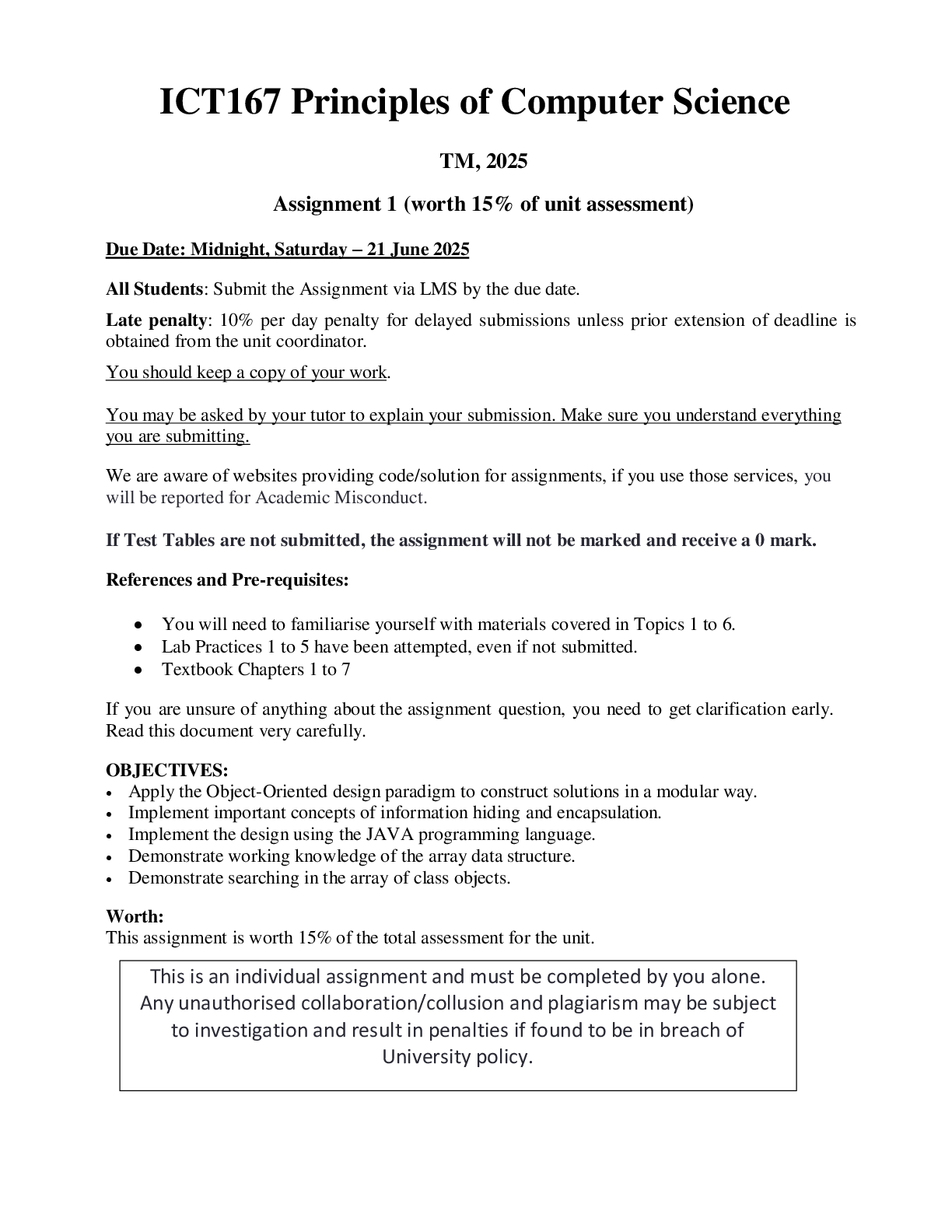

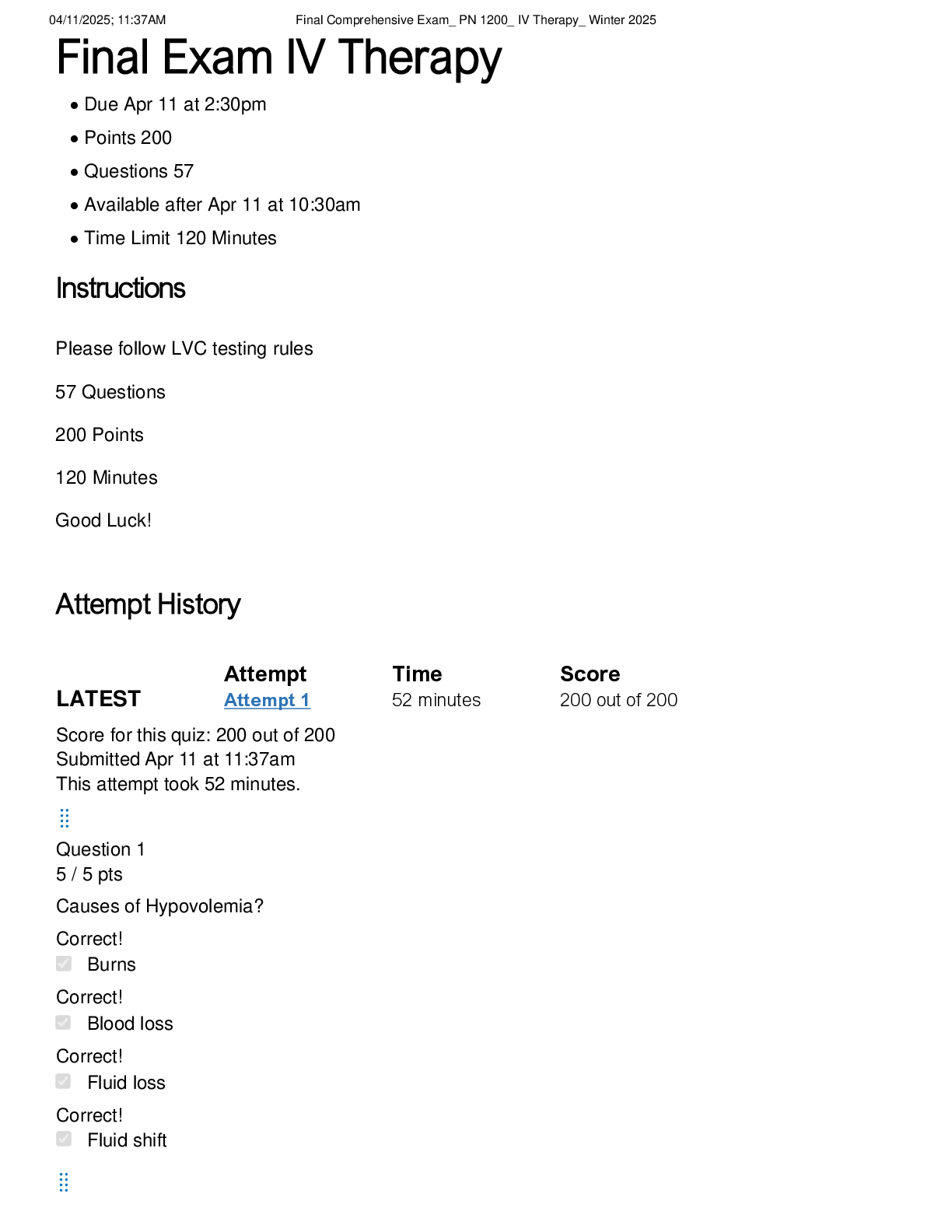
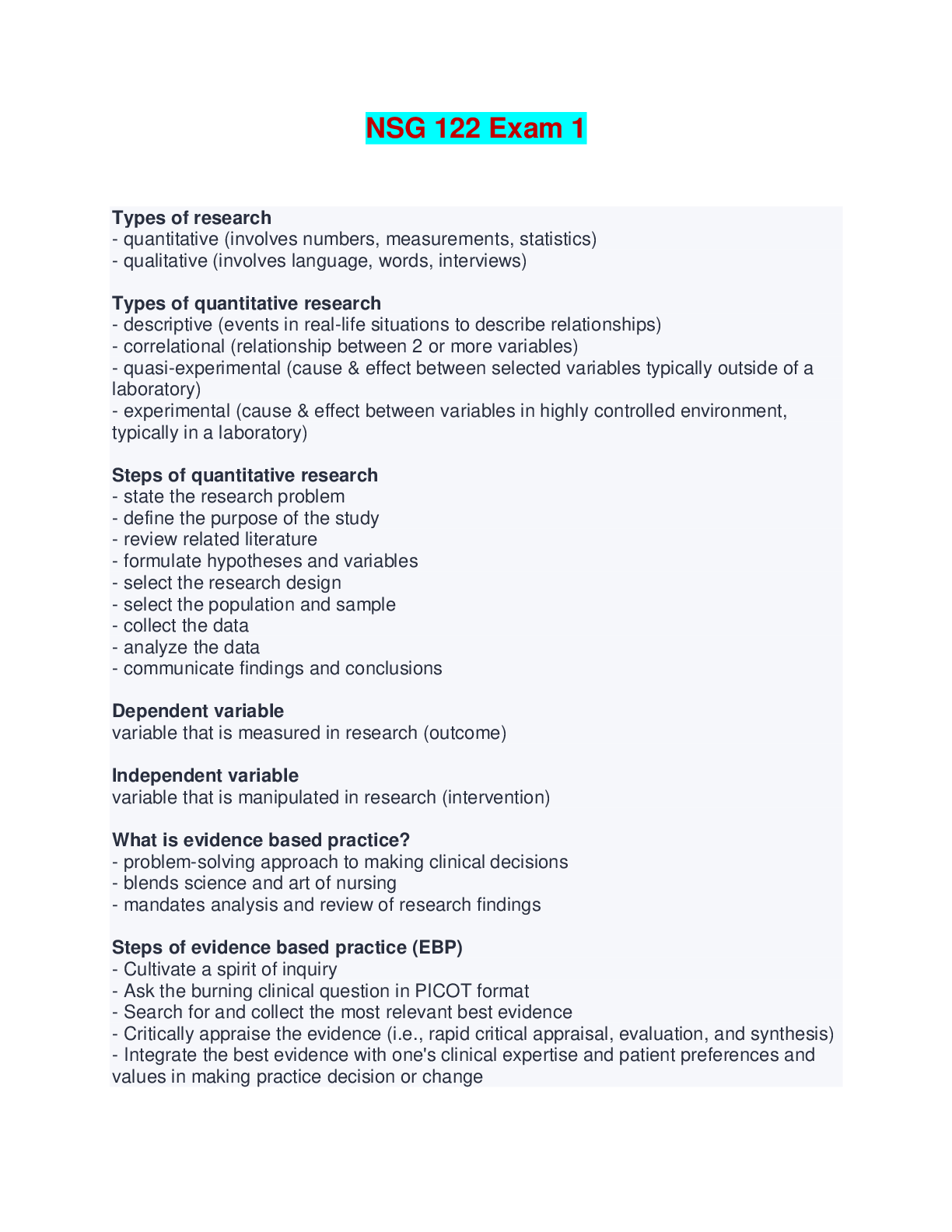
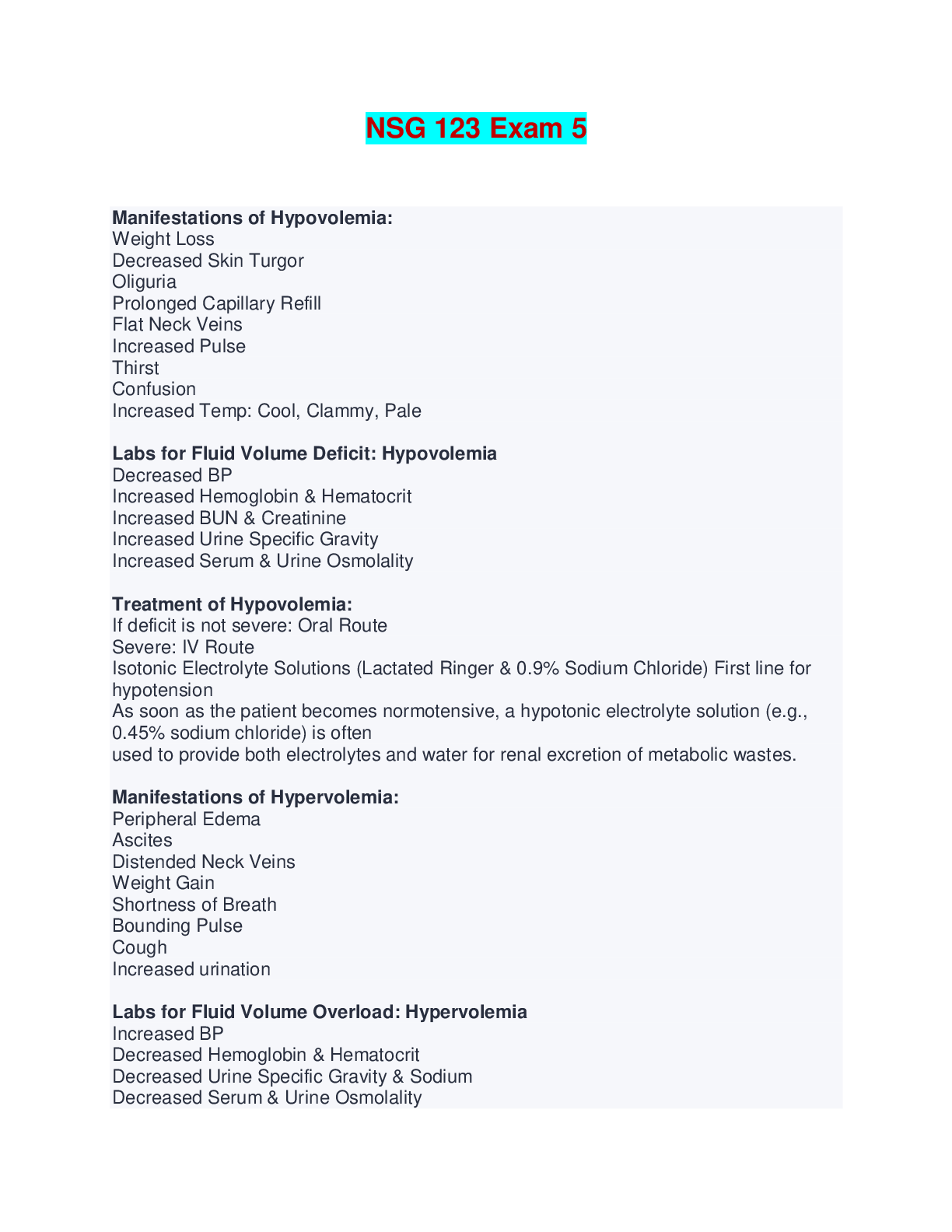
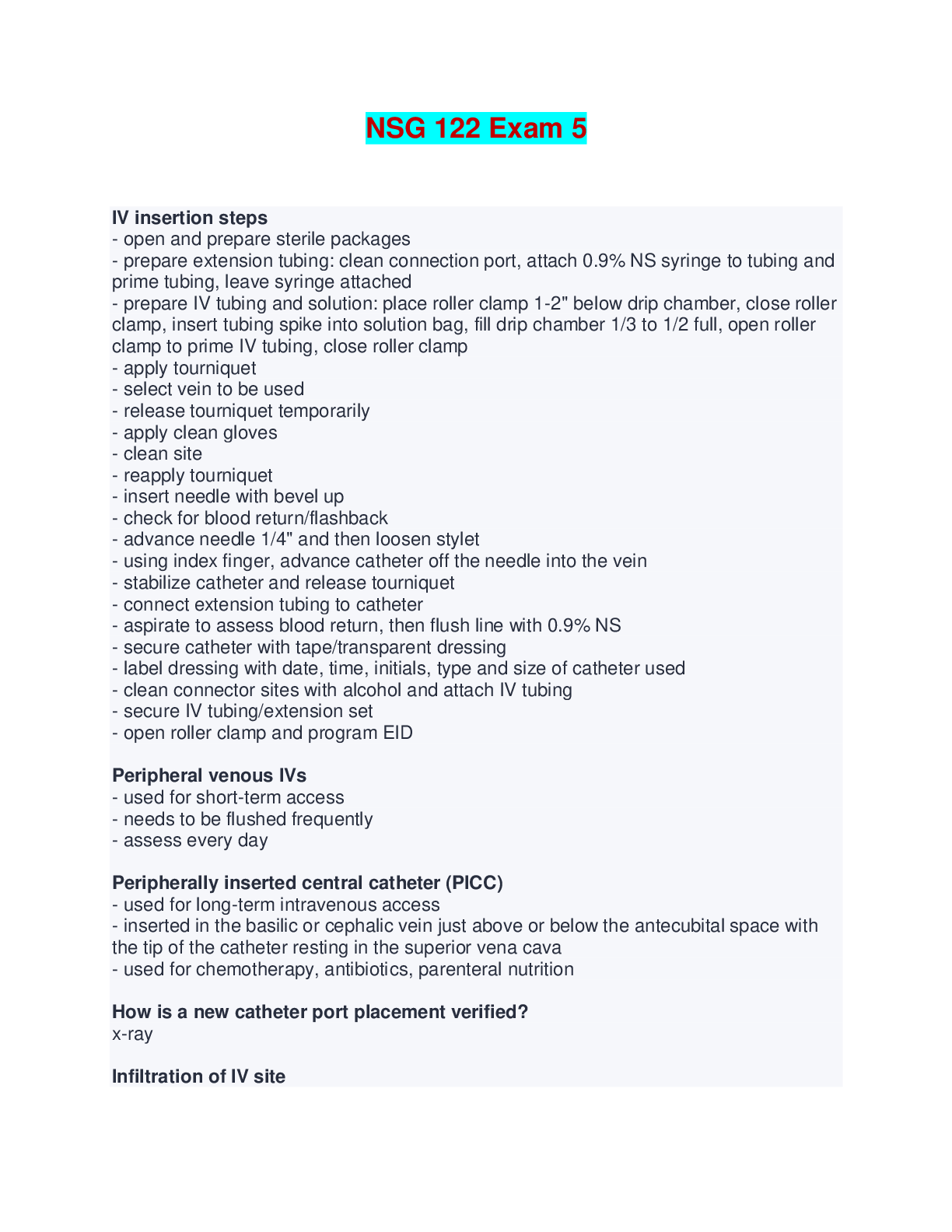


.png)

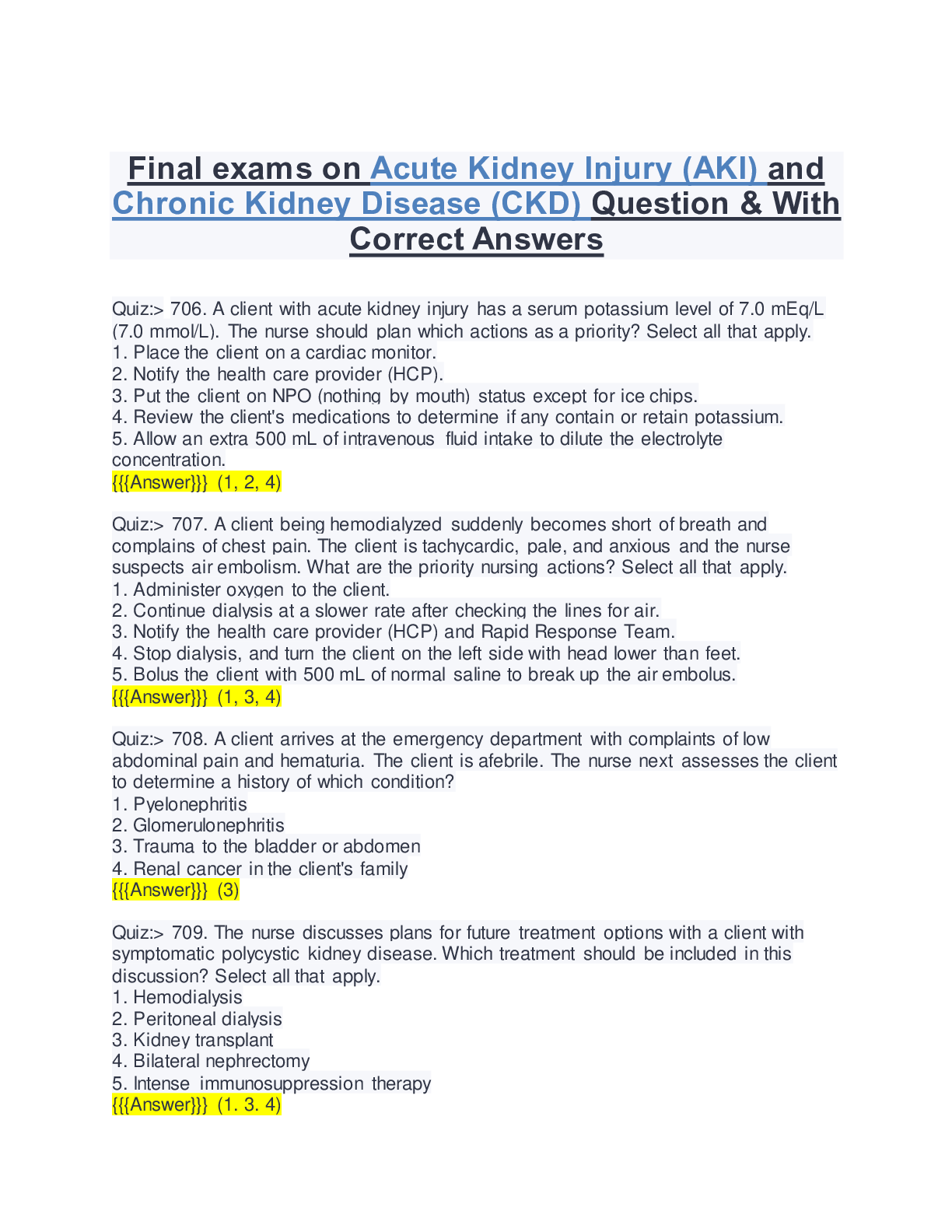




 Answered with Complete Rationales 100% all correct!.png)

